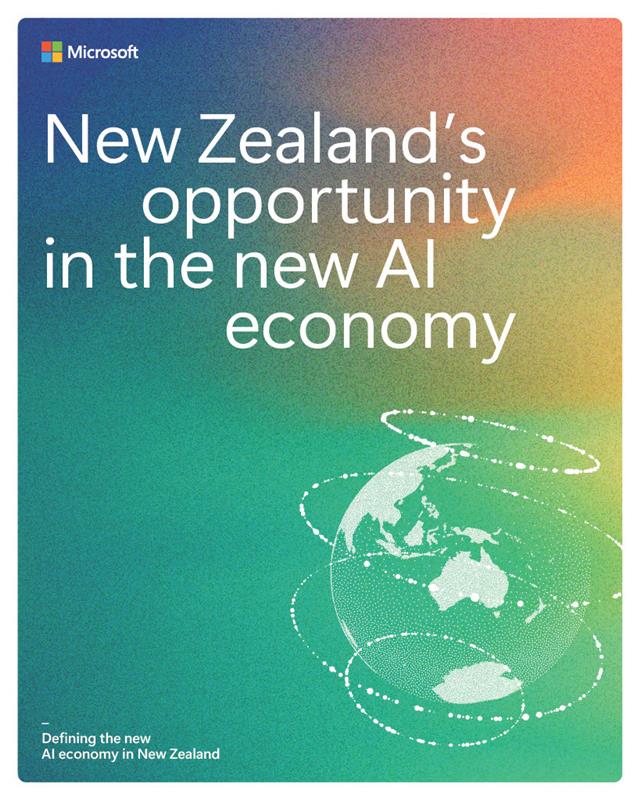
Unlocking New Zealand’s $3.4 billion AI advantage: Where do we invest for the biggest returns?
By Vanessa Sorenson, Managing Director, Microsoft New Zealand
Last year, research from Accenture and Microsoft found that generative AI could contribute between $76 and $108 billion to our economy each year by 2038. And today, new research from Microsoft partner Mandala has unpacked these figures to spell out more clearly just how New Zealand can capitalise on this national opportunity. Realistically, Aotearoa can’t compete on developing major new AI models or a microchip industry with countries and companies that have seemingly bottomless pockets, vast natural resources and bigger populations.
But at the same time, comparisons with similar-sized nations like Singapore, Norway, Finland, Estonia and Portugal find us trailing the pack on most measures, from AI research environment to the start-up economy and skills. In an AI world, we need to address this gap as an urgent priority, or we risk our economy, productivity and social benefits falling further behind.
So, rather than just “doing AI”, what are the specific sectors and kinds of AI investment we should be going after to gain a more competitive position and leverage what we do best?
Thinking local to drive outsized growth
According to the New Zealand’s Opportunity in the New AI Economy report, we need to be investing big in two areas: AI-powered applications and sustainable datacentre infrastructure.
AI applications and AI datacentres together account for more than 90% of the economic potential of AI in Aotearoa.
- Applications: AI apps are expected to generate NZD $2.1 billion in new revenue by 2035, driven by sectors such as healthtech, agritech and fintech. Local companies are already delivering AI-powered solutions globally, including cancer and heart disease detection specialists Volpara; Techion, which has moved from addressing drench resistance in livestock to enabling remote lab diagnostics for humans; accounting hero Xero and HyperCinema, which is reimagining visitor experiences at museums and other venues around the world through personalised, AI-driven storytelling.
- Datacentres: With 88% of electricity generated from renewable sources, a stable political environment, trusted global reputation and proximity to big markets in Asia and Australia, New Zealand is one of the world’s most attractive locations for sustainable AI datacentres – and the investment that naturally follows.
The good news is 84% of Kiwi knowledge workers are already using generative AI – one of the highest adoption rates globally. However, with digital skills lagging our peers, we need to step up our efforts to ensure more people are not only familiar with AI, but truly proficient – especially in the sectors where we already shine, including agriculture, tourism, health and services. In doing so, we can maximise our attractiveness for investment and outcompete our peers.
The Government’s new Public Research Organisation for advanced technology is a great step in this direction. Microsoft is also supporting this shift through a commitment to upskill 100,000 Kiwis in AI and other digital skills over the next two years.
Incentivising strategic infrastructural investments
An optimised development strategy for AI datacentre infrastructure will further enable AI adoption at scale. That means streamlining datacentre approvals and ensuring continued investment in renewable energy. Microsoft’s long-term deal with Contact Energy supported Contact’s decision to construct the Te Huka 3 power station, which can generate 51.4 megawatts of reliable and renewable generation throughout the year. The more we incentivise the development of new datacentres, the more we can increase energy capacity for the benefit of every Kiwi and our business innovators.
But while we have the right conditions for success in these areas, New Zealand’s AI start-up density is still low. The availability of venture capital was identified as a key reason why we’re so far down the list when it comes to AI readiness. With 90% of venture capital funding for AI start-ups coming from overseas in 2023, strengthening local investment and talent pipelines will be key to supercharge success and innovation.
The payoff
- By 2035, AI applications and datacentre infrastructure together could become a $3.4 billion industry in New Zealand.
- Generative AI adoption could increase New Zealand’s GDP per capita by 14%, helping the country leapfrog peers like Finland and Estonia.
- A public sector pilot of Microsoft Copilot showed a 1781% return on investment, saving workers 13 hours a month on repetitive tasks. The wider the adoption, the greater the returns.
It’s encouraging, too, that other members of the New Zealand business community are taking note of the opportunity the AI economy presents our nation:
“At a business level, a lot of the conversation around AI has centred on productivity, and generative AI is already proving itself as an essential tool in that regard. However, the wider conversation around how New Zealand develops an AI industry of its own to create new revenue streams, attract more business and compete in the global market is even more exciting. It underscores the importance of working broadly with government, education providers and employers in a coordinated way to maximise benefits for the economy, to provide certainty to investors in core infrastructure and speed up development and skilling,” said Katherine Rich, Chief Executive of BusinessNZ.
The figures in the report aren’t just abstract projections – they reflect real potential to lift productivity, improve public services, boost exports and create new, high-value jobs, if we focus on the things we do well.
The AI era represents a once-in-a-generation opportunity to capitalise on this “sliding doors moment” to unleash incredible economic opportunity for all New Zealanders. However, building anything strong and resilient needs a plan. As a small but mighty country, it makes sense to stick to our strengths, and the foundations we’ve already laid in app development, datacentres and of course, our core sectors. With our renewable energy advantage, strong institutions, and innovative local companies, we can build an AI-powered economy that’s the envy of all the neighbours.
For more information and to access the full report, click here.

